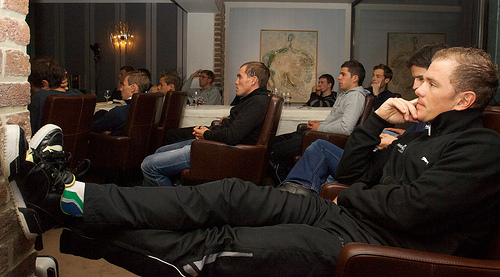As many of you know, undergraduate publishing programs are few and far between. The fact that my undergraduate institution had an editing and publishing minor at all was a resource I only learned of once I had fallen head over heels with the art of editing. With a full heart and open mind, I made it my goal to take every publishing class my school offered. This is how I found myself working on the staff of the literary magazine Silk Road Review: A Literary Crossroads. And let me tell you, my three years as a junior editor-turned-managing editor were nothing like my short time at Ooligan thus far.
Silk Road is a magazine edited by undergraduate and graduate students in the creative writing program at my home institution. It works like this: Undergraduate students wade through a slush pile of short story, nonfiction, and poetry submissions from around the world. Once these undergraduate junior editors find something they like, they send the piece to remotely located graduate students who have the final say on acceptances. However, this process is heavily moderated by faculty members who help with marketing, budgeting, and shaping the magazine’s direction. This is why I was so shocked to learn on my first day at Ooligan Press that everything was completely student run. Whereas students at Silk Road have independence, students at Ooligan have control.
But that’s just the tip of the iceberg. The breadth of Ooligan’s operations are so much more vast than anything I’ve ever dealt with—as it should be. Where Silk Road accepts short-form content that can be answered with a simple thumbs-up or thumbs-down, Ooligan has an entire department (albeit small) whose job is to acquire manuscripts. I’m fascinated to learn more about how this process works. Ooligan Press boasts a host of students who perform edits in various levels of intensity, from deep developmental edits to finishing proofreads. Meanwhile, Silk Road performs one round of polishing copyedits before shipping off to the printer. Silk Road has one web content advisor; Ooligan takes the same job and splits it between two or three people. This boils down to the fact that Ooligan, as a press that publishes full-length books, is much larger than a small literary magazine that puts out an anthology once or twice a year. My first Ooligan executive meeting was the largest amount of people I’ve ever been in a room with who care about publishing just as much as I do.
At the end of the day, interest is really the key factor. Silk Road has fewer resources available because it is a smaller part of a creative writing program. There are fewer moving parts and more heavy burdens on a handful of individuals. Silk Road is a great starting point for those few interested in the editing and publishing program, but for most, it’s a resource for writers to gain experience on the other side of the coin. Contrast this with Ooligan Press—a full publishing press run by students whose primary interest is in publishing—and this leads to more of a team emphasis, allowing specialized leaders to shift the weight around, which allows Ooligan to take on projects of a much larger scope.
The recent weather has prevented me from diving in deep with this program, so I’m not the most knowledgeable about the innermost workings of Ooligan Press yet, but I expect I will be comfortable in no time. Settling in at Ooligan has been an adjustment, but one that has so far proven to be worthwhile.

